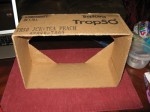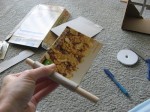Cardboard automata
April 26th, 2014 at 7:48 pm (Engineering, Library School)
Cardboard automata are machines made out of cardboard. They are often operated by a hand crank or dial to initiate the motion. As the primary axle turns, cams attached to it cause cam followers to rise, fall, or spin, depending on their geometry.
Just based on that description, who could resist diving in immediately to make one?
Not me.
Plus, I had an assignment from my Maker Space class to “make something you’ve never made before.” Bingo!
I discovered an excellent set of instructions, with pictures, created by The PIE (Play – Invent – Explore) Institute. I decided it would be a fun challenge to make as much of the project as possible out of “found” (available) items in my home.
 I cut a cardboard box in half, then reinforced the corners to prevent it from collapsing sideways. I cut a hole in each side of the box to connect an axle across it. The instructions suggested using skewers for the axle and cam shafts, but since I didn’t have any, I instead used some wooden dowels I had lying around. I thought they might create a more sturdy result. However, I didn’t have a dowel long enough to span the box, so I temporarily taped three dowels together to build my first prototype. I cut out some cams out of craft foam and slid them onto the axle at different positions.
I cut a cardboard box in half, then reinforced the corners to prevent it from collapsing sideways. I cut a hole in each side of the box to connect an axle across it. The instructions suggested using skewers for the axle and cam shafts, but since I didn’t have any, I instead used some wooden dowels I had lying around. I thought they might create a more sturdy result. However, I didn’t have a dowel long enough to span the box, so I temporarily taped three dowels together to build my first prototype. I cut out some cams out of craft foam and slid them onto the axle at different positions.
 I also created three cam followers by cutting circles out of the foam and inserting more dowels into their centers. Then I cut three holes in the top of the box for the cam followers and connected everything together.
I also created three cam followers by cutting circles out of the foam and inserting more dowels into their centers. Then I cut three holes in the top of the box for the cam followers and connected everything together.
I chose three different cam designs for my three units. The middle cam is round and centered, which generates rotation in the cam follower. The left cam is egg-shaped, which generates rotation and vertical motion. The two right cams are round but off center, and they are positioned to be 180 degrees out of phase. Therefore, they alternate in their contact with the cam follower, which goes up and down and alternates between clockwise and counter-clockwise rotation.
 At this point, when I turned the axle, the dowels wiggled back and forth and sometimes moved themselves off their cams. I consulted the instructions, which advised inserting drinking straws into the top holes so the skewers have a strong guide to keep them aligned. My dowels were far too thick for straws, so I cut up a cereal box to get a firm yet shapeable cardboard sheet. I rolled this cardboard to create tubes that were just slightly larger than the cam shaft dowels. The machine’s performance improved dramatically, and I decided it was time to glue everything down: the tubes in their holes, the cam followers to their shafts, and the cams to the axle. And it worked!
At this point, when I turned the axle, the dowels wiggled back and forth and sometimes moved themselves off their cams. I consulted the instructions, which advised inserting drinking straws into the top holes so the skewers have a strong guide to keep them aligned. My dowels were far too thick for straws, so I cut up a cereal box to get a firm yet shapeable cardboard sheet. I rolled this cardboard to create tubes that were just slightly larger than the cam shaft dowels. The machine’s performance improved dramatically, and I decided it was time to glue everything down: the tubes in their holes, the cam followers to their shafts, and the cams to the axle. And it worked!
Once I had a working machine, I was free to add whatever design elements I wanted. Extending the cardboard design theme, I found instructions for how to make flowers from toilet paper rolls as well as a sprout/palm-like plant for the middle cam shaft. I glued green paper and brown felt onto the top to give it a nature-inspired look, added some paper flowers, and cut out a paper backdrop of twisting grass shapes to accentuate the feeling of motion. Finally, I used colored markers to decorate the cam followers so that their motion (and its direction) is more visually evident, since the mechanism is a focal point of the project.
Here is a longer video that explains the parts of the machine.

